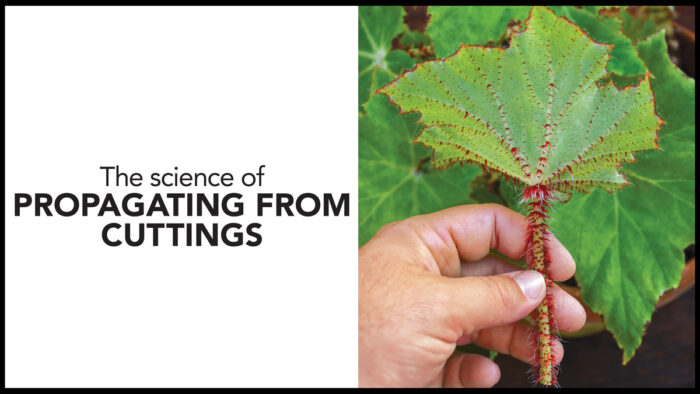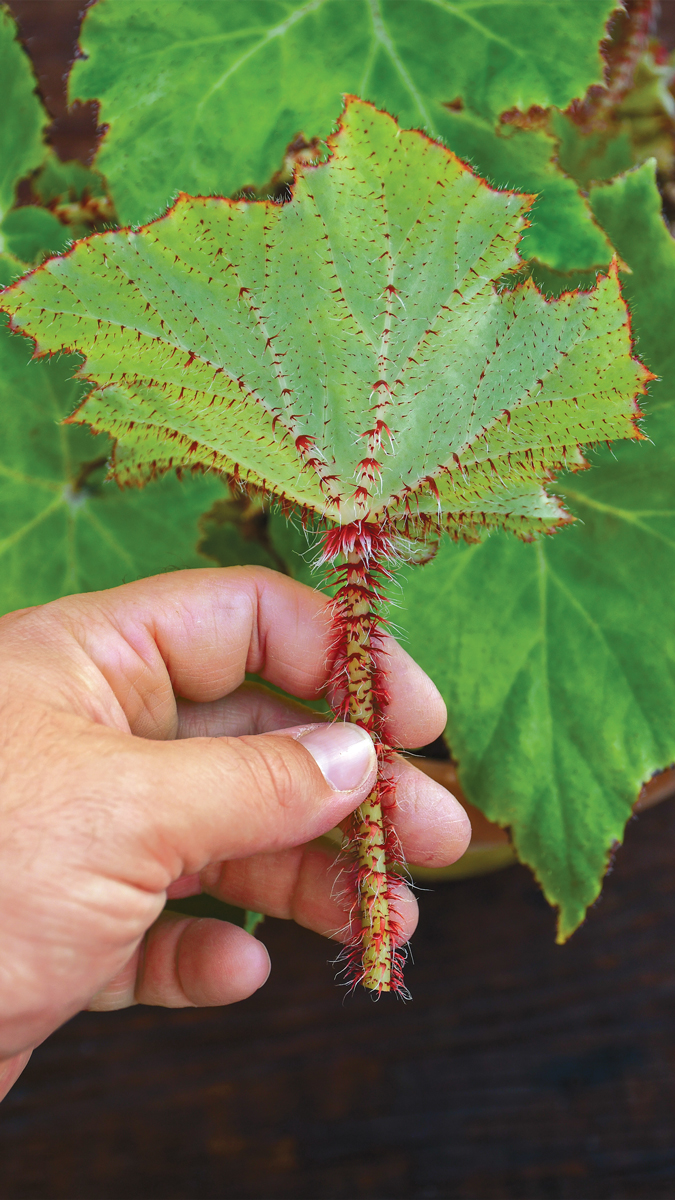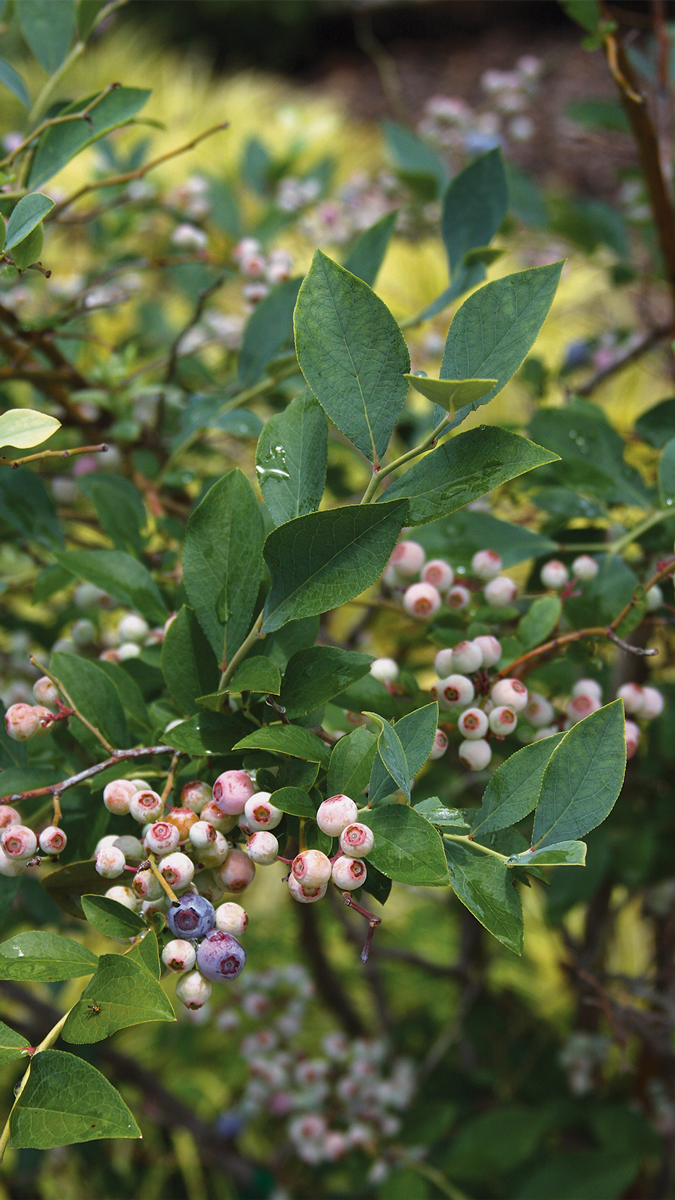
As a kid, I read that new tomato transplants could be started by breaking off suckers and sticking them into potting soil to make new roots. I tried this, and even without a humidity dome, the sucker rooted itself within two weeks. Thrilled to have found a whole new way of making plants, I tried taking cuttings from shrubs and trees. When these weren’t as successful as the tomato, I began to wonder why some plants make better cuttings than others.
In the 20-plus years since I rooted that first tomato sucker, I have learned much more about the incredible science of propagating plants via cuttings. Here is what you need to know to succeed with this useful technique.

What are cuttings?
Cutting propagation is a technique where a root, stem, or leaf is removed from a plant and placed in optimum conditions to allow that plant part, also called a propagule, to regenerate missing organs. This form of vegetative propagation allows gardeners to make an identical copy of a plant, called a clone. Although grafting or tissue culture can also be used to make clones, using cuttings is the best option for beginners because it is relatively quick, inexpensive, and easily performed.
But why should you stick cuttings instead of sowing seed? When seeds are formed, the genetics of two parent plants are mixed, and this process can result in great variation between offspring. In contrast, plant clones from cuttings will have uniform growth and very little variation between them. If a plant is sterile or has difficulty making seed, taking cuttings may be the only way to make more.
Stem cuttings are the main propagation technique that gardeners use, so understanding the science behind their journey from propagule to new plant can help you be more successful in your endeavors.
Take advantage of adventitious tissue
Once a cutting is taken, it has to regenerate roots to quickly reestablish its ability to transpire water and take up nutrients from the soil. We call roots that grow out of a stem or a leaf adventitious, because they occur where we don’t expect them. Plants fall into two categories when they are forming new roots on the stem: They either have preformed root initials, or they must make new roots after wounding.
Preformed root initials in a plant’s stems remain dormant until a stem cutting is made. Then when a cutting is placed in the right conditions, roots develop and emerge. You can see how this wonderful adaptation could be very useful in nature. If a stem comes into contact with soil or water, it can immediately find purchase if the roots are already made—no assembly required! Coleus (Plectranthus scutellarioides, Zones 10–11), sweet potato (Ipomoea spp. and cvs., Zones 9–11), willow (Salix spp. and cvs., Zones 4–9), hydrangea (Hydrangea spp. and cvs., Zones 4–9), tomatoes, and other species have preformed root initials in their stems. Because of that trait, these species root very quickly and with little help from the gardener. For example, when my students have taken sweet potato cuttings and stuck them in water, we have observed new roots emerging within two days.

However, not all species have preformed root initials. To propagate cuttings from a plant that doesn’t have this type of dormant roots, the gardener must induce new roots to grow through wounding. Grape (Vitis spp. and cvs., Zones 4–10), honeysuckle (Lonicera spp. and cvs., Zones 3–10), clematis (Clematis spp. and cvs., Zones 4–9), rose (Rosa spp. and cvs., Zones 3–9), and fig (Ficus spp. and cvs., Zones 7–11) are all examples of plants where wound-induced roots will form after stems have been cut.
When a stem is wounded, tissue will begin to grow and heal over the site to seal the stem. The plant will then begin to produce new roots from existing cells usually located near the vascular tissue in the stem. But something needs to trigger those cells to change roles, and that’s where auxin comes in.
Introducing auxin, the root whisperer
Cutting propagation would be much more difficult if it weren’t for auxin. This plant hormone plays a pivotal role in cell elongation, enabling the creation of roots and the bending of stems in response to light. It is very hard for plant cells to increase in size because of their rigid cell walls. Auxin works by causing the acidification of these tough cell walls, making them more pliable and able to elongate. At a wound site, auxin signals to the plant to begin growing a new root.

How does auxin get to a wound site? Auxin is synthesized in new plant tissues, such as young leaves and shoot meristems, and is then transported downward to the roots, where it helps to initiate new growth underground. An important rule about auxin is that it can only be transported in one direction. When a stem is cut, auxin will accumulate at the end of the cutting that was originally closer to the roots, aiding in the development of new roots at that location.
Considering the one-direction nature of auxin transport, you can understand why sticking the correct end of a cutting into the substrate is so important. If you stick a cutting upside-down, roots will still try to form on the end that was nearer to the roots before it was removed from the plant.
You can also add auxin to a wound site by applying a rooting hormone, available to home gardeners in powder, gel, and liquid formulations. But whether the auxin is naturally made inside the cutting or applied, it will always concentrate at the root end of the cutting.
Choose a stem-cutting method based on how the plant grows
Cuttings are often divided into four categories. For perennials and annuals, gardeners take herbaceous cuttings. For woody plants, the options for propagation are softwood cuttings, hardwood cuttings, and semi-hardwood cuttings. These categories are not referring to the type of wood, but instead to the age of the branch being cut.

Herbaceous cuttings have great flexibility. They can be stuck throughout the year, even in winter, as long as the plant is not killed to the ground and propagation takes place indoors. While you can treat herbaceous cuttings with auxin to help make rooting more uniform, it is usually not necessary. Plants that are often grown from herbaceous cuttings include tomatoes, sweet potatoes, garden mums (Chrysanthemum spp. and cvs., Zones 5–9), poinsettia (Euphorbia pulcherrima and cvs., Zones 9–11), and geranium (Pelargonium spp. and cvs., Zones 9–11).

Softwood cuttings feature very recent growth, under two months old, of soft stem tissues on woody plants. The tissue should not be too weak but also not too rigid. These cuttings need to be stuck quickly, because once they are removed from the plant they become very flaccid. Forsythia (Forsythia spp. and cvs., Zones 4–9), blueberries (Vaccinium spp. and cvs., Zones 2–8), crape myrtle (Lagerstroemia spp. and cvs., Zones 7–9), and weigela (Weigela spp. and cvs., Zones 4–9) all root well as softwood cuttings.

Hardwood cuttings are at the other end of the spectrum. This stem tissue is dormant and can be taken in late fall or winter. Because these cuttings are best stuck while the tissue is not actively growing, they are some of the easiest cuttings for amateurs. There is usually no requirement for misting for deciduous species; however, evergreens do require mist since they still retain their foliage. Some species benefit from rooting hormone application. Species that work well as hardwood cuttings include willow, roses, catalpa (Catalpa spp. and cvs., Zones 4–9), mulberry (Morus spp. and cvs., Zones 4–8), Chinese fringe flower (Loropetalum chinense and cvs., Zones 7–9), chaste tree (Vitex agnus-castus and cvs., Zones 6–9), and buttonbush (Cephalanthus occidentalis and cvs., Zones 5–10).

Semi-hardwood cuttings are in between the other two types. Their tissue is not too soft and not too hard. It is generally two to six months old and still has some leaves present. Semi-hardwood cuttings work well for broadleaf evergreen species such as camellia (Camellia spp. and cvs., Zones 6–10), holly (Ilex spp. and cvs., Zones 5–9), Japanese pittosporum (Pittosporum tobira and cvs., Zones 9–10), and azalea (Rhododendron spp. and cvs., Zones 3–9).
Jared Barnes, Ph.D., is an associate professor of horticulture at Stephen F. Austin State University in Nacogdoches, Texas.


















Comments
Log in or create an account to post a comment.
Sign up Log in